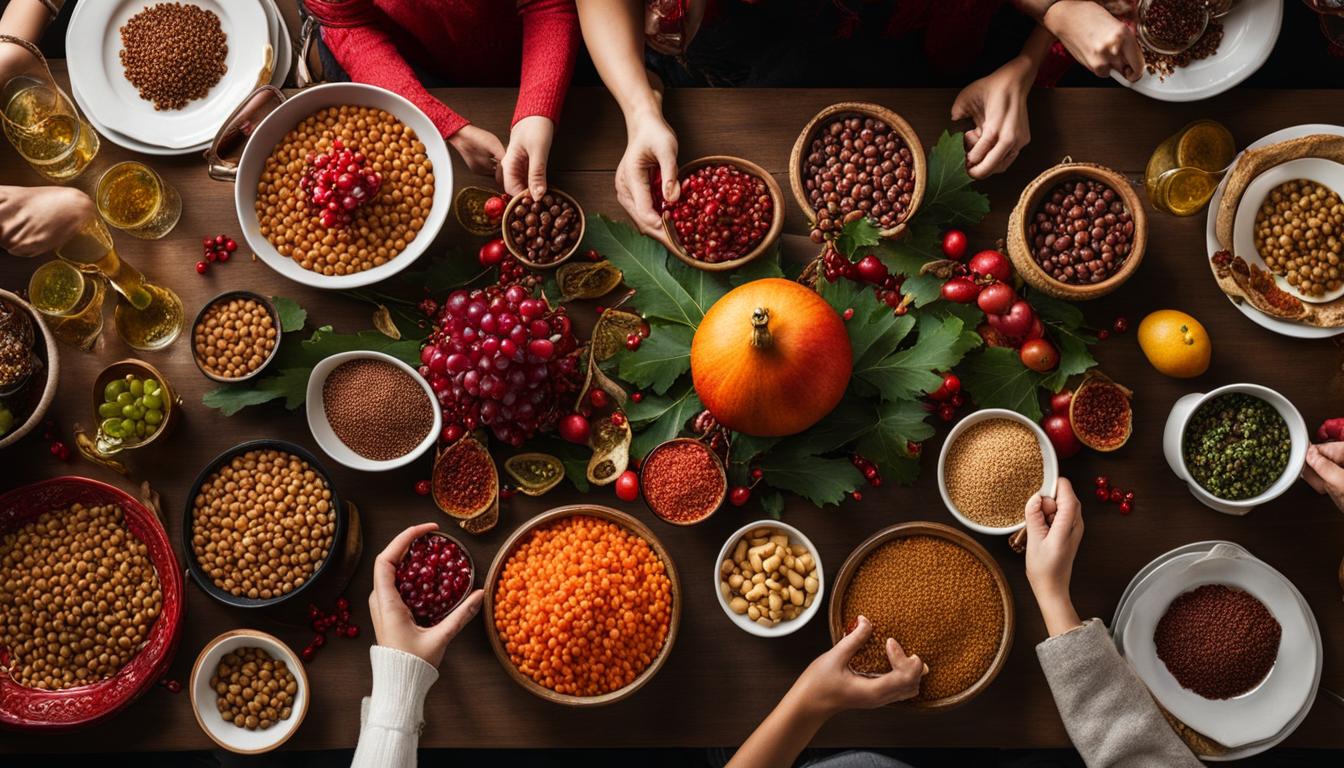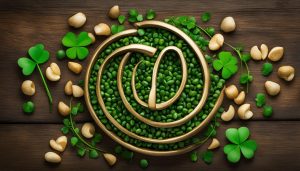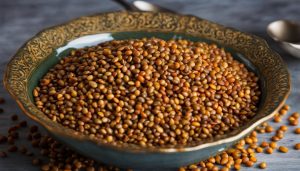Eating certain foods on New Year’s Eve and New Year’s Day has long been believed to bring good luck and prosperity for the upcoming year. These food traditions vary across different cultures and countries. Let’s explore the traditional foods that are considered lucky and bring good fortune on New Years.
Contents
- 1 Ring-shaped Foods: Symbolic of a Full Circle
- 2 Legumes: Bringing Luck and Prosperity
- 3 Symbolic Noodles for Longevity: Savoring Soba Noodles on New Year’s
- 4 Pork: Bringing Wealth and Prosperity
- 5 Fruits and Fish: Symbolic of Luck and Abundance
- 6 Conclusion
- 7 FAQ
- 7.1 What are some traditional New Year’s foods?
- 7.2 Why are ring-shaped foods considered lucky for New Year’s?
- 7.3 What legumes are considered lucky on New Year’s?
- 7.4 What is the significance of long noodles on New Year’s?
- 7.5 Why is pork considered lucky for New Year’s?
- 7.6 What fruits and fish are considered lucky for New Year’s?
- 7.7 What are some traditional New Year’s foods to bring luck and prosperity?
- 8 Source Links
Key Takeaways:
- Ring-shaped foods, like bundt cakes and donuts, symbolize completion and are considered lucky on New Year’s.
- Legumes, such as black-eyed peas and lentils, are believed to bring luck and prosperity for the upcoming year.
- Long noodles, like soba noodles, symbolize longevity and are popular in Asian cultures for New Year’s celebrations.
- Pork dishes are often enjoyed on New Year’s as they symbolize wealth and prosperity.
- Pomegranates and fish are also considered lucky and can bring abundance and good fortune for the New Year.
Ring-shaped Foods: Symbolic of a Full Circle
When it comes to New Year’s traditions, ring-shaped foods hold a special place. These delicious treats symbolize the completion of a full circle, representing the cycle of a year. It is believed that by consuming ring-shaped foods, you invite good luck and prosperity into your life for the upcoming year.
Some popular examples of ring-shaped foods that are enjoyed on New Year’s include bundt cakes, donuts, and bagels. These delectable treats are often enjoyed as part of a New Year’s breakfast or dessert, adding a touch of sweetness to your celebrations. Each bite is a reminder of the infinite possibilities that lie ahead in the coming year.
As you savor these ring-shaped delicacies, take a moment to reflect on the past year and set intentions for the future. Embrace the symbolism of the full circle and embrace the possibilities that await you in the new year.
Table: Ring-shaped Foods for New Year’s
| Food | Description |
|---|---|
| Bundt Cake | A round cake with a hole in the center, often glazed or decorated with festive designs. |
| Donuts | Fried pastries with a ring shape, often filled or topped with various flavors and textures. |
| Bagels | Dense, chewy bread rolls shaped like rings, typically enjoyed with cream cheese or other spreads. |
Indulging in these ring-shaped foods on New Year’s is not only a culinary delight but also a way to connect with traditions and embrace the symbolism of new beginnings. So, go ahead and savor the flavors of these lucky treats as you welcome the upcoming year with open arms.
Legumes: Bringing Luck and Prosperity
When it comes to bringing luck and prosperity on New Year’s, legumes are the way to go. Two popular legumes that are often incorporated into festive dishes are black-eyed peas and lentils. In the Southern United States, black-eyed peas are traditionally served in a dish called Hoppin’ John, which consists of peas cooked with pork, celery, and onion. This flavorful dish is believed to bring luck and good fortune for the upcoming year. Lentils, on the other hand, resemble coins and symbolize abundance. They can be incorporated into various dishes like stews, salads, and dips, making them a versatile and auspicious ingredient to enjoy on New Year’s Day.
Legumes have a long history of being associated with wealth and prosperity. In many cultures, they are believed to bring good luck and ensure a prosperous year ahead. By incorporating legumes into your New Year’s celebration, you are not only indulging in delicious and nutritious dishes but also inviting positive energy into your life.
To further explore the significance of legumes on New Year’s, let’s take a look at the following table:
| Legume | Significance | Popular Dish |
|---|---|---|
| Black-Eyed Peas | Brings luck and good fortune | Hoppin’ John |
| Lentils | Symbolizes abundance and prosperity | Stews, salads, and dips |
As you can see, both black-eyed peas and lentils carry deep symbolic meanings and can be enjoyed in various delicious preparations. So, this New Year’s, consider adding legumes to your menu and embrace the potential for a lucky and prosperous year ahead.
Symbolic Noodles for Longevity: Savoring Soba Noodles on New Year’s
When it comes to New Year’s traditions, there are certain foods that are believed to bring luck and longevity. In many Asian cultures, one such food is noodles, particularly soba noodles. These thin buckwheat noodles hold symbolic meaning and are commonly enjoyed on New Year’s Day.
Soba noodles are known for their length, which symbolizes long life. By eating these noodles, it is believed that you are inviting longevity into your life for the upcoming year. Soba noodles are typically served in a hot broth or chilled with a dipping sauce, making them a versatile and delicious option for your New Year’s meal.
It’s important to note the traditional way of eating soba noodles on New Year’s to fully embrace the symbolism. It’s customary not to break or chew the noodles, as doing so is believed to bring bad luck. Instead, try to slurp and eat the noodles in one continuous strand, honoring the idea of uninterrupted longevity.
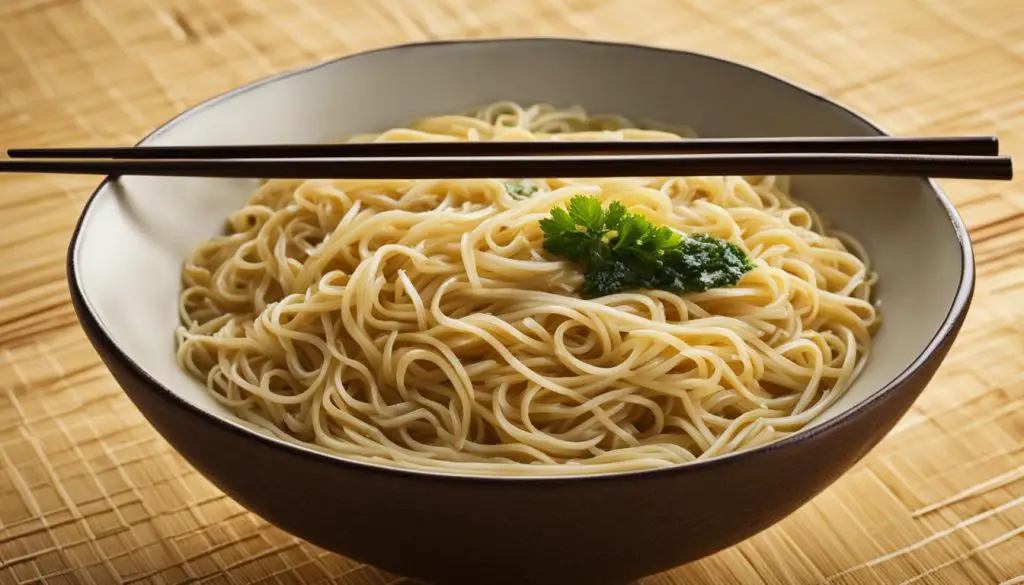
Table: Popular Soba Noodle Dishes for New Year’s
| Dish | Description |
|---|---|
| Zaru Soba | Chilled soba noodles served on a bamboo tray with a soy-based dipping sauce. |
| Tanuki Soba | Soba noodles served in a hot broth with tempura bits sprinkled on top. |
| Kake Soba | Simple soba noodles served in a hot broth with green onions and seaweed. |
| Mori Soba | Cold soba noodles served with a concentrated dipping sauce and various toppings. |
These are just a few examples of the delicious soba noodle dishes you can enjoy on New Year’s. Whether you prefer them chilled or in a comforting hot broth, incorporating soba noodles into your New Year’s meal is a wonderful way to embrace the symbolic meaning of longevity and start the year off on a positive note.
Pork: Bringing Wealth and Prosperity
When it comes to attracting wealth and prosperity in the upcoming year, pork is the culinary star. This flavorful meat is often enjoyed in various dishes on New Year’s Eve to ensure good fortune. Whether you indulge in a juicy pork roast or savor the crispy goodness of pork carnitas, incorporating pork into your New Year’s menu is believed to bring abundance and prosperity. With its rich and savory taste, pork symbolizes wealth and is a delicious way to start the year off right.
In many cultures, pork is considered a lucky food because pigs represent progress and prosperity. This belief dates back to ancient times when farmers would observe pigs’ behaviors, such as their constant rooting forward, as a sign of progress. As a result, consuming pork on New Year’s is thought to bring financial success and positive growth. So, as you gather around the table with loved ones, make sure to include a lucky pork dish to set the tone for a prosperous year ahead.
From succulent pulled pork sandwiches to tender pork chops, there are countless ways to incorporate pork into your New Year’s feast. Not only does pork add a delicious centerpiece to your meal, but it also carries deep symbolic meaning. So, whether you choose to grill, roast, or braise your pork, let this flavorful meat be a reminder of the wealth and abundance that awaits you in the coming year.
Fruits and Fish: Symbolic of Luck and Abundance
When it comes to celebrating the New Year, incorporating fruits and fish into your feast is believed to bring luck and abundance for the upcoming year. In Greek culture, pomegranates are considered symbols of good luck. To invite good fortune into their homes, Greek families traditionally crush a pomegranate at the threshold on New Year’s Eve. The vibrant red seeds are said to represent fertility, prosperity, and a fruitful year ahead.
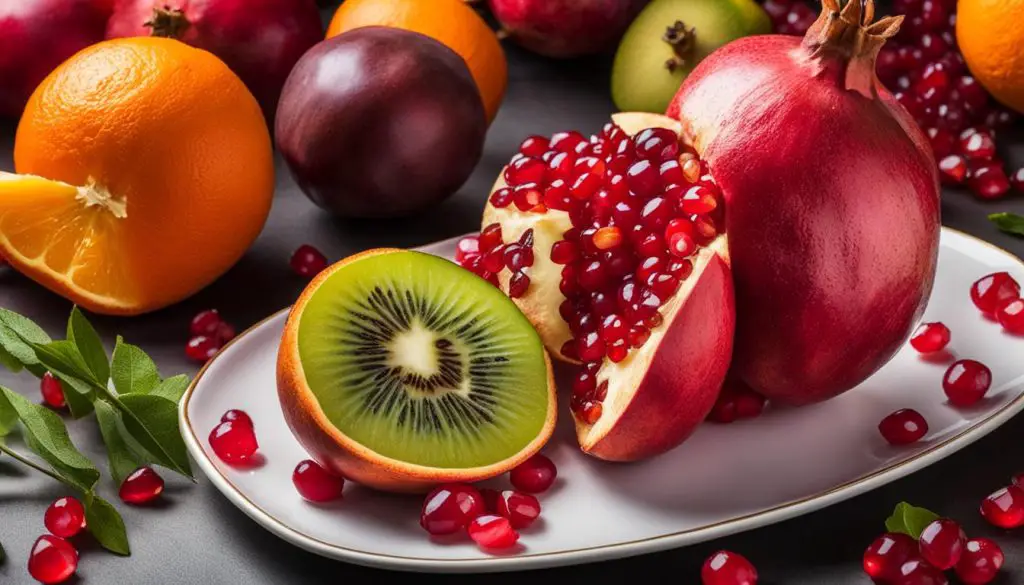
Meanwhile, fish is considered a symbol of abundance and prosperity in many cultures. In Asian traditions, whole fish dishes are popular for New Year’s celebrations. The fish’s scales and swimming motion represent the accumulation of wealth and a continuous flow of prosperity. Grilled stuffed trout or crispy oven-baked fish are often enjoyed during New Year’s Eve or New Year’s Day gatherings to ensure a bountiful year ahead.
Traditional New Year’s Foods Table:
| Food | Symbolism |
|---|---|
| Pomegranates | Good luck and prosperity |
| Fish | Abundance and wealth |
By incorporating these symbolic foods into your New Year’s celebration, you can embrace the rich traditions and beliefs that accompany them. Whether you choose to enjoy a refreshing pomegranate or savor a delicious fish dish, these foods are believed to bring luck, abundance, and prosperity for the year ahead. Start your year off on a positive note and invite good fortune into your life with these traditional New Year’s foods.
Conclusion
As the New Year approaches, it’s time to embrace the traditions of lucky food that bring prosperity and good fortune. Incorporating these traditional New Year’s foods into your celebration can add an extra layer of meaning to your festivities and set the stage for a prosperous year ahead.
Whether you choose to enjoy black-eyed peas for luck, indulge in long noodles for longevity, or savor a delicious pork dish for wealth, these time-honored culinary traditions carry cultural significance and a sense of anticipation. By starting the year off with the right foods, you are inviting luck and prosperity into your life.
So, as you gather with loved ones to welcome the New Year, remember the significance of these lucky foods. May the flavors and symbolism of the traditional New Year’s cuisine bring you joy, abundance, and fulfillment in 2022.
FAQ
What are some traditional New Year’s foods?
Some traditional New Year’s foods include ring-shaped foods, legumes, long noodles, pork, and fruits like pomegranates. These foods are believed to bring luck, prosperity, and abundance for the upcoming year.
Why are ring-shaped foods considered lucky for New Year’s?
Ring-shaped foods symbolize the completion of a full circle, representing the cycle of a year. Eating foods like bundt cakes, donuts, and bagels on New Year’s is believed to bring good luck and prosperity for the coming year.
What legumes are considered lucky on New Year’s?
Black-eyed peas and lentils are popular choices for bringing luck and prosperity on New Year’s. In the Southern United States, black-eyed peas are traditionally served with pork, celery, and onion in a dish called Hoppin’ John. Lentils, which resemble coins, are also considered lucky and symbolize abundance.
What is the significance of long noodles on New Year’s?
Eating long noodles on New Year’s is believed to bring long life. For example, soba noodles, a type of Japanese noodle, are often consumed on New Year’s Day. It is important to not break or chew the noodles, as it is believed to bring bad luck.
Why is pork considered lucky for New Year’s?
Pork is a common choice for New Year’s dishes as it symbolizes wealth and prosperity. Whether it’s pork carnitas, roast pork, or a whole roast chicken, these dishes are often enjoyed on New Year’s Eve to bring abundance and good fortune for the upcoming year.
What fruits and fish are considered lucky for New Year’s?
In Greek culture, pomegranates are considered good luck. Greek families often crush a pomegranate at the threshold of their home to bring good fortune for the New Year. Additionally, fish is a symbol of abundance and prosperity in many cultures. Whole fish, like grilled stuffed trout or crispy oven-baked fish, are often enjoyed on New Year’s Eve or New Year’s Day to ensure a year of wealth and good fortune.
What are some traditional New Year’s foods to bring luck and prosperity?
Traditional New Year’s foods like ring-shaped foods, legumes, long noodles, pork, and fruits and fish symbolize luck, prosperity, abundance, and wealth. Incorporating these foods into your celebration is believed to bring good fortune for the upcoming year.

